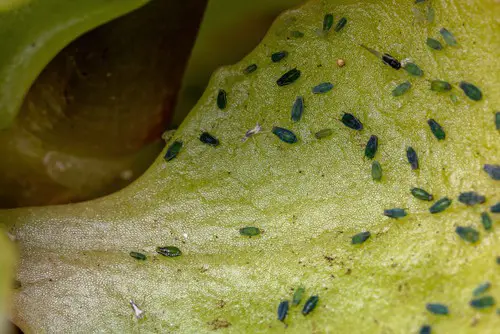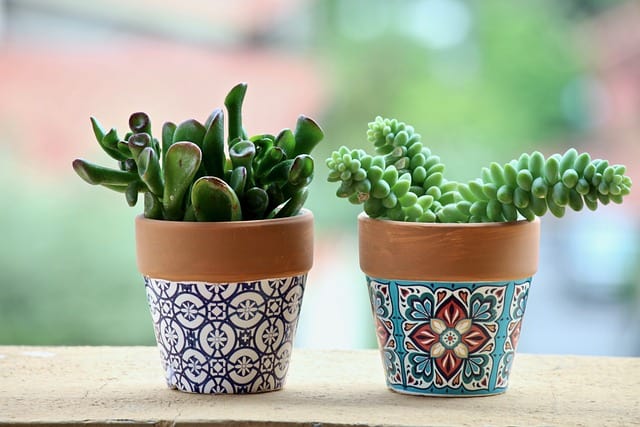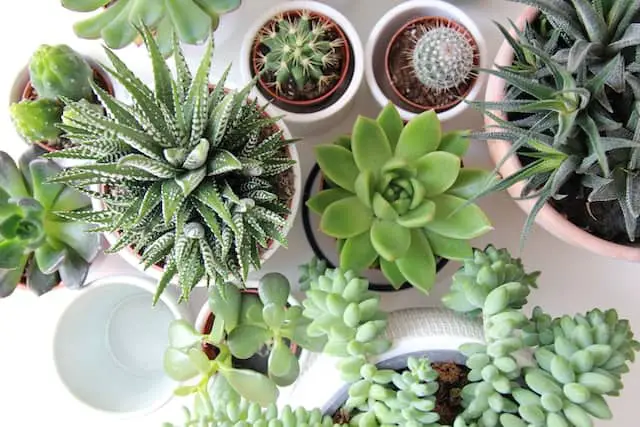Succulents are mesmerizing plants that are famous for thriving against all odds. Although we often marvel at the beauty and tenacity of these adorable plants, have you ever wondered what lurks beneath their succulent charm?
From tiny insects to larger herbivores, a surprising range of creatures love to feed on succulents for nutritional and hydration purposes. Join me as we delve into the intriguing topic of what eats succulents and, importantly, the appropriate ways to protect your cherished plant from predators & diseases.
Thanks to their unique shapes, colors, and low-maintenance needs, succulents are popular for indoor and outdoor gardening. But, like all plants, succulents are not immune to pests and diseases. One of the most common problems that succulent growers face is damage caused by animals and insects that feed on these adorable plants’ foliage and stems.
This article will explore some of the most common predators of succulents and provide tips for protecting your plants and dealing with infestations. Following these guidelines can keep your succulents healthy and thriving for years.
Key Takeaways on What Eats Succulents
- Succulent plants are vulnerable to various pests and diseases, including animals and insects that eat their leaves and stems.
- Natural predators of succulents include everything from tiny aphids and thrips to larger animals like deer and rodents.
- Identifying these problems early on and preventing infestation keeps your plant beautiful and healthy.
Natural Predators of Succulents

1. Insects
Succulents are a favorite prey for many insects that feed on the plant’s sap. Some of the most common insects that feed on succulent plants include aphids, caterpillars, mealybugs, thrips, red spider mites, whitefly, and long-tailed mealybug.
These insects cause damage to the succulent leaves, leading to discoloration, wilt, and stunted growth. They also attack the tender sprouting plants.
2. Rodents and Animals
Succulent plants are also vulnerable to attacks from rodents and other animals. Rats, squirrels, possums, rabbits, deer, prairie dogs, camels, and even tortoises have been known to feed on succulent plants.
These animals cause physical damage to the succulent leaves and stem, leading to hydration problems and stunted growth. They also uproot the plant, causing it to wither and die.
3. Birds
Birds are another natural predator of succulent plants. The juicy, succulent leaves attract birds such as the Gila woodpecker and can cause significant damage to the plant. The best action to prevent bird damage is using bird netting or bird repellents.
4. Slugs and Snails
Slugs and snails are also known to feed on succulent plants. They cause significant damage to the plant by eating the leaves and stem. They leave behind a slimy trail, which is a sign of infestation. To prevent slugs and snails from attacking your succulent plants, you can use slug and snail bait or set up barriers around the plant.
5. Chipmunks and Cats
Chipmunks and cats are also natural predators of succulent plants. They cause significant damage by digging around the base of the plant or uprooting it. Setting barriers around the plant and using cat-repellent sprays will protect your succulents from these animals.
Diseases and Infestations

Succulents are generally hardy plants but can still fall victim to several diseases and pests. These issues can cause discoloration, wilt, stunted growth, and other signs of poor health. Identifying and addressing these problems immediately is vital to prevent them from spreading to other plants.
Identifying Infestations
The first step in dealing with any pest problem is identifying the signs of infestation. Typical symptoms of infestation include discoloration, yellowing, defoliation, stunted growth and tender new growth. Regularly inspect your plants to identify these problems early on.
Common Succulent Pests
Mealybugs are one of the most common pest problems for succulents. You can quickly identify them if you notice your succulents have a white, cotton-like appearance. Thrips are another common pest that can cause damage to succulents.
They are small, slender insects that cause discoloration and defoliation. Red spider mites, another menace for succulents, might be challenging to notice because of their tiny stature. However, your plants might have red spider mites infestation if you see yellow leaves and stunted growth.
Finally, whiteflies cause significant damage to succulents. Check for small, white insects, causing your plants to lose color and defoliation.
Preventative Measures
Appropriate preventive measures are the best when dealing with pests and diseases. Some preventative measures you can take to protect your succulents include:
- Keeping your plants well hydrated
- Avoiding over-fertilization
- Keeping your plants in a humid environment
- Using natural predators to control pests
- Using deterrents and repellents to keep pests away
Treatment and Management
Some treatment options include using insecticides, natural predators, and repellents. Vinegar and peppermint oil can also be effective deterrents for specific pests. Removing affected leaves or plant parts will also help prevent infestation. Proper treatment and management ensure your succulents are healthy and thriving.
Protecting Your Succulents

Some practical and effective methods of protecting your succulent plants from pests, animals and diseases include:
1. Fencing and Netting
Fencing or netting is one of the most effective ways to protect outdoor succulents. This can prevent larger animals, such as deer, rabbits, and prairie dogs, from accessing your plants. In addition, use bird netting to keep flying creatures from pecking at your succulent leaves.
2. Repellents and Deterrents
Cat-repellent sprays, vinegar and peppermint, can help keep animals and insects away from succulents. White vinegar and peppermint help deter rodents and certain insects.
3. Protecting Indoor Succulents
Indoor succulents can also risk being eaten by insects such as mealybugs and white flies. To protect indoor succulents, regularly inspect them for signs of infestation and take action immediately. More importantly, adopting the proper succulent care routine will prevent infestation and damage.
4. Protecting Outdoor Succulents
Outdoor succulents are at risk of being eaten by various animals and insects, including chipmunks, cats, slugs, snails, grasshoppers, birds, possums, and rabbits. To protect outdoor succulents, try using fencing or netting, as well as repellents and deterrents.
5. Promoting Healthy Succulent Growth
In addition to protecting your succulents from predators, it’s vital to consider their overall health and growth. Proper hydration and a clean environment will keep these hardy plants healthy.
Moreso, don’t overwater as it can lead to root rot. It’s not advisable to plant or keep your succulents near vegetables, herbs, or other plants that produce a lot of plant sap, as this can attract white flies.
By taking these steps to protect your succulents and promote their growth, you can ensure they remain healthy and beautiful for years.
Check out these other informative posts on proper succulent care:
Frequently Asked Questions

What animals are known to eat succulents?
Cats, rats, squirrels, rabbits, deer, possums, and even birds are some of the animals that have developed a taste for these resilient plants. These animals can cause damage to succulents by eating the leaves, stems, or roots.
How can I identify if mealybugs, spider mites, aphids, scale insects, whiteflies, or thrips are eating my succulents?
You can easily identify these pests if your succulents are discolored or have deformed leaves. Scale insects tend to create a waxy coating on the leaves. On the other hand, whiteflies and thrips cause yellowing and wilting of the leaves.
What are some signs that pests are eating my succulents?
Signs of pest damage can include holes in the leaves, discoloration, wilting, and deformities in the succulent. You may also notice small insects or pests on the leaves or stems of the plant.
What are some practical ways to prevent pests from eating my succulents?
Some practical ways to prevent pests from eating your succulents include using physical barriers like fencing or netting, companion planting with plants that repel pests, using repellents like neem oil or garlic spray, and practicing good sanitation by removing dead leaves or debris that can harbor pests.
How can I protect my succulents from rodents like rats, squirrels, raccoons, and rabbits?
To protect your succulents from rodents, use physical barriers like fencing or netting, repellents like predator urine or hot pepper spray, and remove any potential food sources like fallen fruit or seeds.
What steps can I take to keep my succulents healthy and pest-free?
To keep your succulents healthy and pest-free:
Please provide them with proper sunlight, water, and soil.
Avoid over-watering and over-fertilizing, as this can attract pests.
Regularly inspect your succulents for signs of pest damage and take action promptly to prevent further damage.

Hey, I’m Lisa and I’ve been an avid gardener for over 30 years. I love writing, talking and living in the garden! Feel free to connect with me on my socials below

